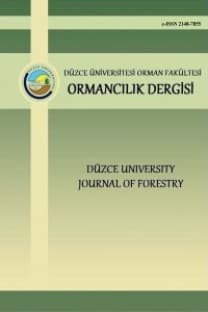Laminat Parkede Yanmayı Geciktirici Kimyasal Maddelerin Küf Mantarı Direnci Üzerine Etkilerinin Araştırılması
Küf mantarı, boraks, laminat parke, amonyum polifosfat
Investigation of Effects of Fire Retardant Chemical Substances on Mold Resistance in Laminate Parquet
Mold, borax, laminate flooring,
___
- ASTM D 4445–10. Standard Test Method for Fungicides for Controlling Sapstain and Mold on Unseasoned Lumber (Laboratory Method),
- Ayrılmış, N., Candan, Z., White, R., 2007. Physical, mechanical, and fire properties of oriented strandboard with fire retardant treated veneers. Holz Roh- Werkst 65, 449–45,
- Berkel, A. 1972. Ağaç Malzeme Teknolojisi Cilt II: Ağaç Malzemenin Korunması ve Emprenye Tekniği, İstanbul Üniversitesi Orman Fakültesi, İ.Ü. Yayın No: 1745, O.F.Yayın No: 183, s. 386,
- Fogel, JL., Lloyd, JD, 2002. Mold performance of some construction products with and without borate. Forest Prod. J. 52(2), 38-43,
- İlhan, R. 1999. Ağaç Malzeme Teknolojisi I, Muğla Üniversitesi, Teknik Eğitim Fakültesi, Muğla, s. 165.
- Laks, PE., Quan, X., Palardy, R. D., 2002. Fungal susceptibility of interior commercial building panels. Forest Prod. J. 52(5), 41-44,
- Lloyd, JD., 1998. Borates and Their Biological Applications. The İnternational Research Group on Wood Preservation 29 th Annual Meeting, IRG/WP/98–30178, Maastricht, Nederlands,
- Terzi, E., Kartal, SN., White, RH., Shinoda, K., Imamura, Y., 2011. Fire performance and decay resistance of solid wood and plywood treated with quaternary ammonia compounds and common fire retardants. J. Wood Prod. 69, 41–51,
- Yamaguchi, H. 2003. Silicic acid: Boric Acid Complexes as Wood Preservatives. Wood Sei Technology 37, 287–297,
- Yalınkılıç, MK., Yusuf, S., Yoshimura, T., Takahashi, M., Tsunoda, K. 1996. Effect of Vapor Phaseformalizationof Boric Acid Treated Wood on Boron Leachability and Biological Resistance. İn; Proceedings of Third Pacific RimBio-Based Composite Symposium, Kyoto, Japan, pp. 544–551.
- ISSN: 2148-7871
- Yayın Aralığı: Yılda 2 Sayı
- Başlangıç: 2005
- Yayıncı: Haldun Müderrisoğlu
Türkiye, Karabucak’ta Yetişen Okaliptüs Grandis’in Öz Odun ve Diri Odununun Mekanik Özellikleri
Bekir Cihad BAL, İbrahim BEKTAŞ
Peyzaj Fonksiyonlarının Hendek İlçesi Örneğinde Değerlendirilmesi
Aybike Ayfer KARADAĞ, Kerem YILDIZ
Akçakoca (Batı Karadeniz) Balıkçılığı ve Balıkçıların Sosyo-Ekonomik Analizi
Mehmet Onurhan GÜCÜŞ, Hüdaverdi EROĞLU
Isıtma İşleminin Kızılçam (Pinus brutia Ten.) Tohumlarının Çimlenmesine Etkisi
Avrupa Ülkeleri ile Türkiye’nin Kuşe Kâğıt Üretimi ve Dış Ticaret Miktarları Üzerine Bir Araştırma
İlker AKYÜZ, Esat GÜMÜŞKAYA, Tarık GEDİK
Şemsettin KULAÇ, Deniz GÜNEY, Emrah ÇİÇEK, Şeyma SOMAY, Ali Kemal ÖZBAYRAM
Ferhat ÖZDEMİR, Ahmet TUTUŞ, Selim ŞEN
A3 Karesi İçin Yeni Floristik Kayıtlar (Taşlıyayla ve Kızık Yaylaları)
